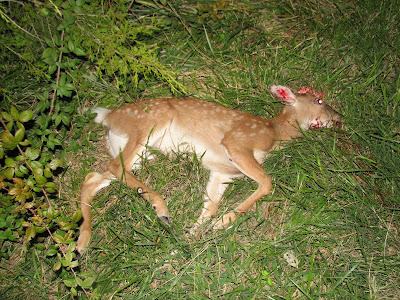
Does and fawns have been plentiful on Aspen Ridge in the Town Branch watershed this spring and summer. Don Hoodenpyle's gardens and a few acorn-producing oaks in the small park north of World Peace Wetland Prairie have kept encouraging them to migrate each night from a mile or two to the south.
A little after 8 p.m. Friday another fawn hit the pavement west of Beechwood Avenue when a vehicle was unable to stop as the little deer crossed the road from south to north, heading into the still-vegetated area along the west arm of the Town Branch of the West Fork of the White River but possibly headed all the way to Pinnacle Prairie and World Peace Wetland Prairie or Aspen Ridge and Don Hoodenpyle's garden.
Young deer are plentiful now. Several cross Aspen Ridge between Rochier Hill, Pinnacle Prairie, World Peace Wetland Prairie and Hoodenpyle's garden near the main arm of the Town Branch every night. If you doubt it, walk across Aspen Ridge and count the tracks of several sizes. Then go right after a rain when the tracks are melted away and return the following day and try to count how many different deer have made the many tracks.
There'll be one less the next time it rains. That fawn's tracks may still be visible on Aspen Ridge, but the next rain will wipe out the final evidence that the fawn ever existed. And let's hope does don't suffer as much as women when their young are killed. But don't pretend they aren't disappointed or saddened or grieved or something similar to what we think of as uniquely human emotions.
Our city needs to bring a serious, experienced wildlife biologist onboard to help plan wildlife corridors along with the trail planner. Deer, coyotes and such should not be forced to cross a lot of paved, heavily traveled streets to get to the places where their ancestors always did their midnight grocery shopping.
Admittedly, some people don't want any wildlife in the city and destroy their own trees, shrubs and native tall grass to get rid of them. But most of the destruction of habitat is for new construction. New construction sites can be planned with consideration for all living things. And some architects and engineers are willing to participate. Can we get everyone on board?





No comments:
Post a Comment